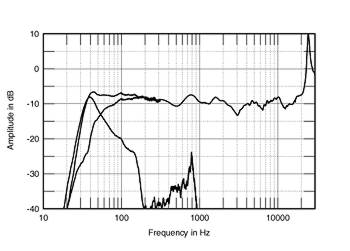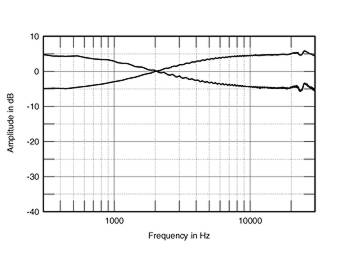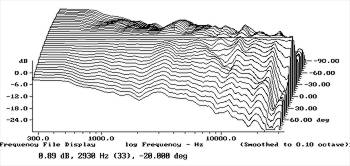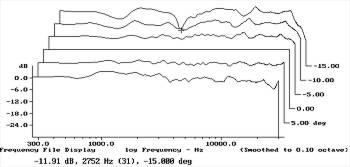| Columns Retired Columns & Blogs |
Meridian Digital Theatre surround-sound music system Measurements DSP5000
Sidebar 4: Measurements Meridian DSP5000
Although Kal used the DSP5000s as rear-channel speakers, they are respectable full-range speakers in their own right. I thus performed a complete set of measurements using the DRA Labs MLSSA system, a calibrated B&K microphone, and a dCS 904 A/D converter running at 96kHz sampling to convert the analog test signal to digital.
As a digital-input active speaker, the DSP5000 doesn't have a meaningful voltage-sensitivity rating. However, driving it with a noise signal at -12dBFS and with its volume control set to "70" (out of a possible "99'') gave a B-weighted level at 1m of 84dB(B), which implies that a pair will give SPLs well above 100dB.
The speaker's balance, with its tilt control set to "0" and averaged across a 30 degree horizontal window on the tweeter axis (fig.11), is basically flat, with small peaks balanced by equally small dips. The usual ultrasonic tweeter resonance at 25kHz rises some 20dB above the reference level. While this will never be excited by playing back CDs, it will be by 96kHz-sampled material, which might have an unpredictable effect on sound quality. To the left of this graph are shown the nearfield responses of the woofers and the port, as well as their complex sum. The port appears to be tuned to 40Hz, but the overall bass alignment is higher than the normal fourth-order reflex, with a steeper rollout. A peak at 800Hz can be seen in the port's output, but as this is low in level and the port faces away from the listener, it should have no subjective consequences.

Fig.11 Meridian DSP5000, anechoic response on tweeter axis at 50", averaged across 30 degrees horizontal window and corrected for microphone response, with the nearfield woofer and port responses and their complex sum plotted below 300Hz, 900Hz, and 300Hz, respectively.
The unusual tilt control can be set in numeric "0.5" steps between "+10" and "-10": fig.12 shows its effect on the on-axis response when set to its extremes, with the latter subtracted out to reveal just the action of the control. It can be seen to hinge the speaker's output around 2kHz, with a maximum boost/cut of ±5dB. A useful tone control.

Fig.12 Meridian DSP5000, effect of tilt control set to ±"10," normalized to response on tweeter axis at 50".
The DSP5000 has excellent lateral dispersion, fig.13 revealing a wide, well-controlled radiation pattern with just a trace of beaming above 20kHz and at the top of the woofers' passband, where it will tend to compensate for the on-axis suckout in the same region. In the vertical plane (fig.14), the speaker's balance doesn't change much over a wide (±10 degrees) window centered on the tweeter axis, which is a lowish 33" from the floor.

Fig.13 Meridian DSP5000, lateral response family at 50", normalized to response on tweeter axis, from back to front: differences in response 90 degrees-5 degrees off-axis, reference response, differences in response 5 degrees-90 degrees off-axis.

Fig.14 Meridian DSP5000, vertical response family at 50", from back to front: differences in response 15 degrees-5 degrees above tweeter axis, reference response, differences in response 5 degrees-10 degrees below tweeter axis.
- Log in or register to post comments




































